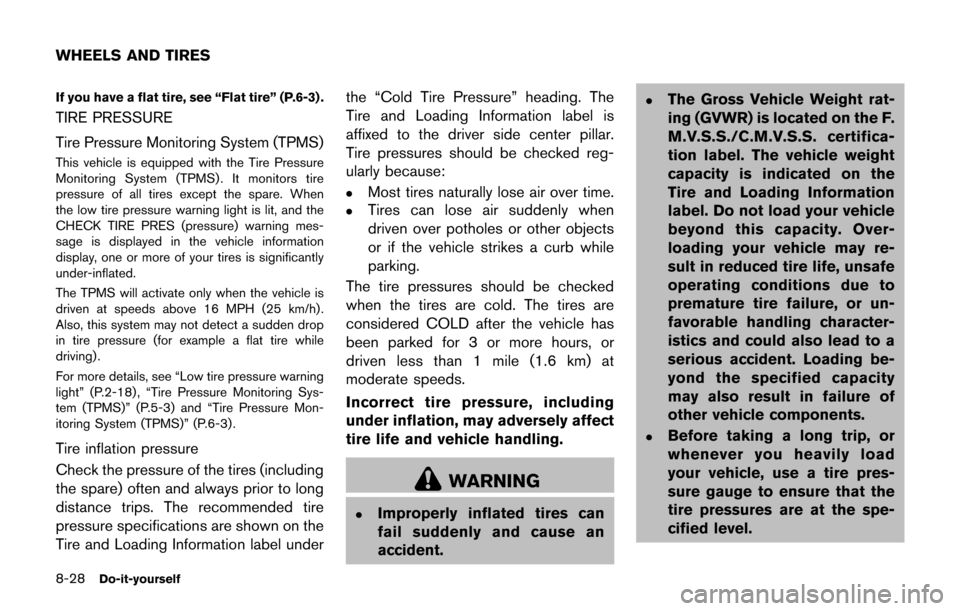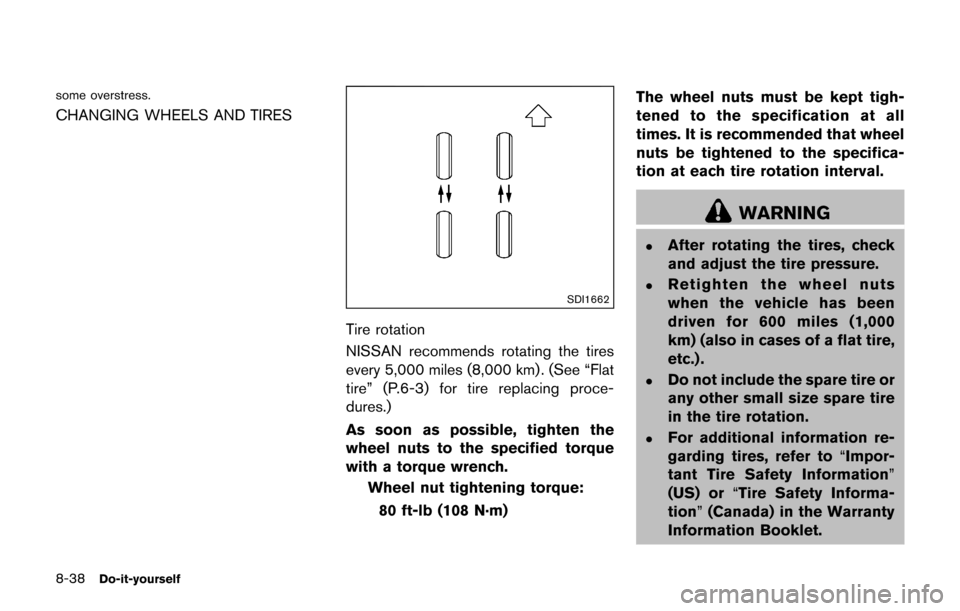2017 NISSAN JUKE flat tire
[x] Cancel search: flat tirePage 353 of 416

8-28Do-it-yourself
If you have a flat tire, see “Flat tire” (P.6-3) .
TIRE PRESSURE
Tire Pressure Monitoring System (TPMS)
This vehicle is equipped with the Tire Pressure
Monitoring System (TPMS) . It monitors tire
pressure of all tires except the spare. When
the low tire pressure warning light is lit, and the
CHECK TIRE PRES (pressure) warning mes-
sage is displayed in the vehicle information
display, one or more of your tires is significantly
under-inflated.
The TPMS will activate only when the vehicle is
driven at speeds above 16 MPH (25 km/h) .
Also, this system may not detect a sudden drop
in tire pressure (for example a flat tire while
driving) .
For more details, see “Low tire pressure warning
light” (P.2-18) , “Tire Pressure Monitoring Sys-
tem (TPMS)” (P.5-3) and “Tire Pressure Mon-
itoring System (TPMS)” (P.6-3) .
Tire inflation pressure
Check the pressure of the tires (including
the spare) often and always prior to long
distance trips. The recommended tire
pressure specifications are shown on the
Tire and Loading Information label underthe “Cold Tire Pressure” heading. The
Tire and Loading Information label is
affixed to the driver side center pillar.
Tire pressures should be checked reg-
ularly because:
.Most tires naturally lose air over time.
.Tires can lose air suddenly when
driven over potholes or other objects
or if the vehicle strikes a curb while
parking.
The tire pressures should be checked
when the tires are cold. The tires are
considered COLD after the vehicle has
been parked for 3 or more hours, or
driven less than 1 mile (1.6 km) at
moderate speeds.
Incorrect tire pressure, including
under inflation, may adversely affect
tire life and vehicle handling.
WARNING
.Improperly inflated tires can
fail suddenly and cause an
accident.
.The Gross Vehicle Weight rat-
ing (GVWR) is located on the F.
M.V.S.S./C.M.V.S.S. certifica-
tion label. The vehicle weight
capacity is indicated on the
Tire and Loading Information
label. Do not load your vehicle
beyond this capacity. Over-
loading your vehicle may re-
sult in reduced tire life, unsafe
operating conditions due to
premature tire failure, or un-
favorable handling character-
istics and could also lead to a
serious accident. Loading be-
yond the specified capacity
may also result in failure of
other vehicle components.
.Before taking a long trip, or
whenever you heavily load
your vehicle, use a tire pres-
sure gauge to ensure that the
tire pressures are at the spe-
cified level.
WHEELS AND TIRES
Page 355 of 416

8-30Do-it-yourself
SDI2503
Tire and Loading Information label
*1Seating capacity: The maximum
number of occupants that can be
seated in the vehicle.
*2Vehicle load limit: See “Vehicle
loading information” (P.10-15) .
*3Original size: The size of the tires
originally installed on the vehicle at
the factory.
*4Cold tire pressure: Inflate the tires to
this pressure when the tires are
cold. Tires are considered COLDafter the vehicle has been parked for
3 or more hours, or driven less than
1 mile (1.6 km) at moderate speeds.
The recommended cold tire inflation
is set by the manufacturer to provide
the best balance of tire wear, vehicle
handling, driveability, tire noise, etc.,
up to the vehicle’s GVWR.
*5Tire size — see “Tire labeling” (P.8-
34) .
*6Spare tire size or compact spare tire
size (if so equipped)
Page 357 of 416

8-32Do-it-yourself
Except for NISMO and NISMO RS models:
SIZECOLD TIRE INFLATION
PRESSURE
FRONT ORIGINAL TIRE P215/55R17 93V 230 kPa, 33 PSI (2WD
MT models)
250 kPa, 36 PSI (2WD
CVT models)
240 kPa, 35 PSI (AWD
models)
REAR ORIGINAL TIRE P215/55R17 93V 230 kPa, 33 PSI (2WD
MT models)
250 kPa, 36 PSI (2WD
CVT models)
240 kPa, 35 PSI (AWD
models)
SPARE TIRE T135/80D16 101M (2WD
models)
T135/90D16 102M (AWD
models) 420 kPa, 60 PSI
Page 358 of 416

For NISMO models:
SIZECOLD TIRE INFLATION
PRESSURE
FRONT ORIGINAL TIRE 225/45R18 95Y 230 kPa, 33 PSI (2WD
MT models)
240 kPa, 35 PSI (AWD
models)
REAR ORIGINAL TIRE 225/45R18 95Y 230 kPa, 33 PSI (2WD
MT models)
240 kPa, 35 PSI (AWD
models)
SPARE TIRE T135/80D16 101M (2WD
models)
T135/90D16 102M (AWD
models) 420 kPa, 60 PSI
Do-it-yourself8-33
Page 359 of 416

8-34Do-it-yourself
For NISMO RS models:
SIZECOLD TIRE INFLATION
PRESSURE
FRONT ORIGINAL TIRE 225/45R18 95Y 230 kPa, 33 PSI (2WD
MT models)
240 kPa, 35 PSI (AWD
models)
REAR ORIGINAL TIRE 225/45R18 95Y 230 kPa, 33 PSI (2WD
MT models)
240 kPa, 35 PSI (AWD
models)
SPARE TIRE T135/70D17 92M 420 kPa, 60 PSI
SDI1575
Example
TIRE LABELING
Federal law requires tire manufacturers
to place standardized information on the
sidewall of all tires. This information
identifies and describes the fundamental
characteristics of the tire and also
provides the tire identification number
(TIN) for safety standard certification.
The TIN can be used to identify the tire
in case of a recall.
Page 361 of 416

8-36Do-it-yourself
4. Three-digit code: Tire type code(Optional)
5. Four numbers represent the week and year the tire was built. For
example, the numbers 3103 means
the 31st week of 2003. If these
numbers are missing, then look on
the other sidewall of the tire.
*3Tire ply composition and material
The number of layers or plies of rubber-
coated fabric in the tire.
Tire manufacturers also must indicate the
materials in the tire, which include steel,
nylon, polyester, and others.
*4Maximum permissible inflation pres-
sure
This number is the greatest amount of air
pressure that should be put in the tire.
Do not exceed the maximum permissible
inflation pressure.
*5Maximum load rating
This number indicates the maximum load
in kilograms and pounds that can be carried by the tire. When replacing the
tires on the vehicle, always use a tire that
has the same load rating as the factory
installed tire.
*6Term of “tubeless” or “tube type”
Indicates whether the tire requires an
inner tube (“tube type”) or not (“tube-
less”) .
*7The word “radial”
The word “radial” is shown, if the tire has
radial structure.
*8Manufacturer or brand name
Manufacturer or brand name is shown.
Other tire-related terminology:
In addition to the many terms that are
defined throughout this section, Intended
Outboard Sidewall is (1) the sidewall
that contains a whitewall, bears white
lettering or bears manufacturer, brand
and/or model name molding that is
higher or deeper than the same molding
on the other sidewall of the tire, or (2) the
outward facing sidewall of an asymme- trical tire that has a particular side that
must always face outward when
mounted on a vehicle.
TYPES OF TIRES
WARNING
.
When changing or replacing tires,
be sure all four tires are of the same
type (Example: Summer, All Season
or Snow) and construction. A
NISSAN dealer may be able to help
you with information about tire type,
size, speed rating and availability.
. Replacement tires may have a lower
speed rating than the factory
equipped tires, and may not match
the potential maximum vehicle
speed. Never exceed the maximum
speed rating of the tire.
. Replacing tires with those not ori-
ginally specified by NISSAN could
affect the proper operation of the
TPMS.
. For additional information regard-
ing tires, refer to “Important Tire
Safety Information” (US) or“Tire
Safety Information” (Canada) in the
Page 363 of 416

8-38Do-it-yourself
some overstress.
CHANGING WHEELS AND TIRES
SDI1662
Tire rotation
NISSAN recommends rotating the tires
every 5,000 miles (8,000 km) . (See “Flat
tire” (P.6-3) for tire replacing proce-
dures.)
As soon as possible, tighten the
wheel nuts to the specified torque
with a torque wrench.Wheel nut tightening torque:
80 ft-lb (108 N·m) The wheel nuts must be kept tigh-
tened to the specification at all
times. It is recommended that wheel
nuts be tightened to the specifica-
tion at each tire rotation interval.
WARNING
.After rotating the tires, check
and adjust the tire pressure.
.Retighten the wheel nuts
when the vehicle has been
driven for 600 miles (1,000
km) (also in cases of a flat tire,
etc.) .
.Do not include the spare tire or
any other small size spare tire
in the tire rotation.
.For additional information re-
garding tires, refer to
“Impor-
tant Tire Safety Information”
(US) or “Tire Safety Informa-
tion” (Canada) in the Warranty
Information Booklet.
Page 386 of 416

10 Technical and consumer information
Capacities and recommended fluids/lubricants ............. 10-2Fuel information ................................................................ 10-4
Engine oil and oil filter recommendation .................... 10-7
Air conditioning system refrigerant and
lubricant recommendations ............................................ 10-8
Specifications ........................................................................\
.. 10-9
Engine ........................................................................\
......... 10-9
Wheels and tires .............................................................. 10-9
Dimensions and weights ............................................. 10-10
When traveling or registering in another country ....... 10-10
Vehicle identification ........................................................... 10-11 Vehicle Identification Number (VIN) plate ............... 10-11
Vehicle identification number (chassis number) .... 10-11
Engine serial number .................................................... 10-11
F.M.V.S.S./C.M.V.S.S. certification label ................. 10-12
Emission control information label ............................ 10-12
Tire and Loading Information label ........................... 10-12
Air conditioner specification label ............................. 10-13
Installing front license plate .............................................. 10-13 Vehicle loading information .............................................. 10-15
Terms ........................................................................\
...... 10-15
Vehicle load capacity ................................................. 10-15
Loading tips .................................................................. 10-17
Measurement of weights ........................................... 10-17
Towing a trailer .................................................................... 10-18
Flat towing ........................................................................\
.... 10-18 Continuously Variable Transmission (CVT) .......... 10-18
Manual Transmission .................................................. 10-18
Uniform tire quality grading .............................................. 10-19
Treadwear ..................................................................... 10-19
Traction AA, A, B and C ........................................... 10-19
Temperature A, B and C ........................................... 10-19
Emission control system warranty .................................. 10-20
Reporting safety defects .................................................. 10-20
Readiness for Inspection/Maintenance (I/M) test ...... 10-21
Event Data Recorders (EDR) .......................................... 10-22
Owner’s manual/service manual order information ..... 10-22